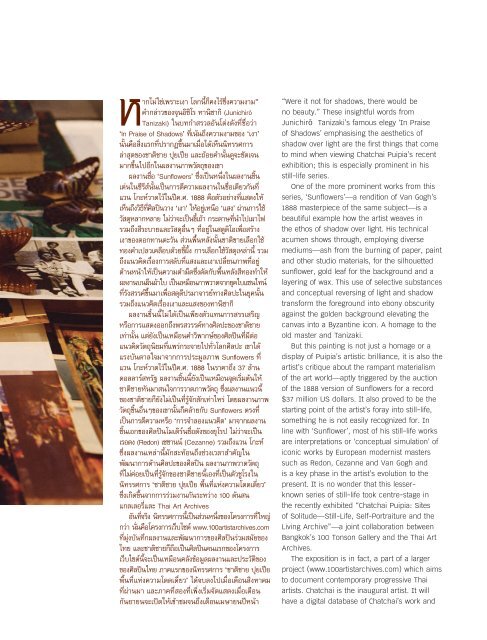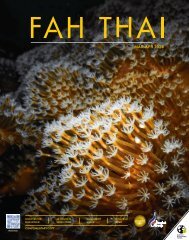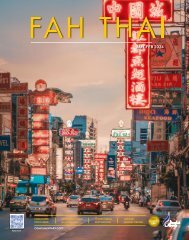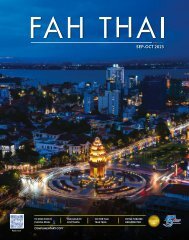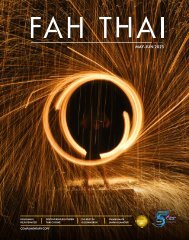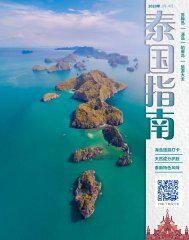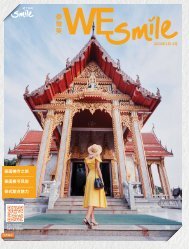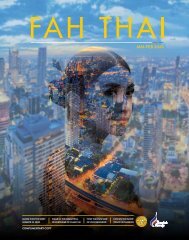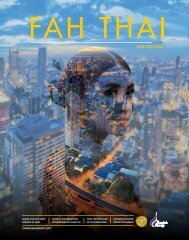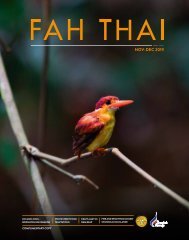WE Smile Magazine October 2015
The In-Flight Magazine of Thai Smile Airways
The In-Flight Magazine of Thai Smile Airways
Create successful ePaper yourself
Turn your PDF publications into a flip-book with our unique Google optimized e-Paper software.
หากไม่ใช่เพราะเงา โลกนี้ก็คงไร้ซึ่งความงาม”<br />
คำากล่าวของจุนอิชิโร ทานิซากิ (Junichirō<br />
Tanizaki) ในบทกำาสรวลอันโด่งดังที่ชื่อว่า<br />
‘In Praise of Shadows’ ที่เน้นถึงความงามของ ‘เงา’<br />
นั้นคือสิ่งแรกที่ปรากฏขึ้นมาเมื่อได้เห็นนิทรรศการ<br />
ล่าสุดของชาติชาย ปุยเปีย และถ้อยคำานั้นดูจะชัดเจน<br />
มากขึ้นไปอีกในผลงานภาพวัตถุของเขา<br />
ผลงานชื่อ ‘Sunflowers’ ซึ่งเป็นหนึ่งในผลงานชิ้น<br />
เด่นในซีรีส์นั้นเป็นการตีความผลงานในชื่อเดียวกันที่<br />
แวน โกะห์วาดไว้ในปีค.ศ. 1888 คือตัวอย่างที่แสดงให้<br />
เห็นถึงวิธีที่ศิลปินวาง ‘เงา’ ให้อยู่เหนือ ‘แสง’ ผ่านการใช้<br />
วัสดุหลากหลาย ไม่ว่าจะเป็นขี้เถ้า กระดาษที่นำ าไปเผาไฟ<br />
รวมถึงสีระบายและวัสดุอื่นๆ ที่อยู่ในสตูดิโอเพื่อสร้าง<br />
เงาของดอกทานตะวัน ส่วนพื้นหลังนั้นชาติชายเลือกใช้<br />
ทองคำาเปลวเคลือบด้วยขี้ผึ้ง การเลือกใช้วัสดุเหล่านี้ รวม<br />
ถึงแนวคิดเรื่องการสลับที่แสงและเงาเปลี่ยนภาพที่อยู่<br />
ด้านหน้าให้เป็นความดำามืดซึ่งตัดกับพื้นหลังสีทองทำาให้<br />
ผลงานบนผืนผ้าใบ เป็นเหมือนภาพวาดจากยุคไบแซนไทน์<br />
ที่รังสรรค์ขึ้นมาเพื่อสดุดีปรมาจารย์ทางศิลปะในยุคนั้น<br />
รวมถึงแนวคิดเรื่องเงาและแสงของทานิซากิ<br />
ผลงานชิ้นนี้ไม่ได้เป็นเพียงตัวแทนการสรรเสริญ<br />
หรือการแสดงออกถึงพรสวรรค์ทางศิลปะของชาติชาย<br />
เท่านั้น แต่ยังเป็นเหมือนคำาวิพากษ์ของศิลปินที่มีต่อ<br />
แนวคิดวัตถุนิยมที่แพร่กระจายไปทั่วโลกศิลปะ เขาได้<br />
แรงบันดาลใจมาจากการประมูลภาพ Sunflowers ที่<br />
แวน โกะห์วาดไว้ในปีค.ศ. 1888 ในราคาถึง 37 ล้าน<br />
ดอลลาร์สหรัฐ ผลงานชิ้นนี้ยังเป็นเหมือนจุดเริ่มต้นให้<br />
ชาติชายหันมาสนใจการวาดภาพวัตถุ ซึ่งผลงานแนวนี้<br />
ของชาติชายก็ยังไม่เป็นที่รู้จักสักเท่าไหร่ โดยผลงานภาพ<br />
วัตถุชิ้นอื่นๆของเขานั้นก็คล้ายกับ Sunflowers ตรงที่<br />
เป็นการตีความหรือ ‘การจำาลองแนวคิด’ มาจากผลงาน<br />
ชิ้นเอกของศิลปินโมเดิร์นชื่อดังของยุโรป ไม่ว่าจะเป็น<br />
เรอดง (Redon) เซซานน์ (Cezanne) รวมถึงแวน โกะห์<br />
ซึ่งผลงานเหล่านี้มักสะท้อนถึงช่วงเวลาสำาคัญใน<br />
พัฒนาการด้านศิลปะของศิลปิน ผลงานภาพวาดวัตถุ<br />
ที่ไม่ค่อยเป็นที่รู้จักของชาติชายนี้เองที่เป็นตัวชูโรงใน<br />
นิทรรศการ ‘ชาติชาย ปุยเปีย พื้นที่แห่งความโดดเดี่ยว’<br />
ซึ่งเกิดขึ้นจากการร่วมงานกันระหว่าง 100 ต้นสน<br />
แกลเลอรี่และ Thai Art Archives<br />
อันที่จริง นิทรรศการนี้เป็นส่วนหนึ่งของโครงการที่ใหญ่<br />
กว่า นั่นคือโครงการเว็บไซต์ www.100artistarchives.com<br />
ที่มุ่งบันทึกผลงานและพัฒนาการของศิลปินร่วมสมัยของ<br />
ไทย และชาติชายก็ถือเป็นศิลปินคนแรกของโครงการ<br />
เว็บไซต์นี้จะเป็นเหมือนคลังข้อมูลผลงานและประวัติของ<br />
ของศิลปินไทย ภาคแรกของนิทรรศการ ‘ชาติชาย ปุยเปีย<br />
พื้นที่แห่งความโดดเดี่ยว’ ได้จบลงไปเมื่อเดือนสิงหาคม<br />
ที่ผ่านมา และภาคที่สองที่เพิ่งเริ่มจัดแสดงเมื่อเดือน<br />
กันยายนจะเปิดให้เข้าชมจนถึงเดือนเมษายนปีหน้า<br />
“Were it not for shadows, there would be<br />
no beauty.” These insightful words from<br />
Junichirō Tanizaki’s famous elegy ‘In Praise<br />
of Shadows’ emphasising the aesthetics of<br />
shadow over light are the first things that come<br />
to mind when viewing Chatchai Puipia’s recent<br />
exhibition; this is especially prominent in his<br />
still-life series.<br />
One of the more prominent works from this<br />
series, ‘Sunflowers’—a rendition of Van Gogh’s<br />
1888 masterpiece of the same subject—is a<br />
beautiful example how the artist weaves in<br />
the ethos of shadow over light. His technical<br />
acumen shows through, employing diverse<br />
mediums—ash from the burning of paper, paint<br />
and other studio materials, for the silhouetted<br />
sunflower, gold leaf for the background and a<br />
layering of wax. This use of selective substances<br />
and conceptual reversing of light and shadow<br />
transform the foreground into ebony obscurity<br />
against the golden background elevating the<br />
canvas into a Byzantine icon. A homage to the<br />
old master and Tanizaki.<br />
But this painting is not just a homage or a<br />
display of Puipia’s artistic brilliance, it is also the<br />
artist’s critique about the rampant materialism<br />
of the art world—aptly triggered by the auction<br />
of the 1888 version of Sunflowers for a record<br />
$37 million US dollars. It also proved to be the<br />
starting point of the artist’s foray into still-life,<br />
something he is not easily recognized for. In<br />
line with ‘Sunflower’, most of his still-life works<br />
are interpretations or ‘conceptual simulation’ of<br />
iconic works by European modernist masters<br />
such as Redon, Cezanne and Van Gogh and<br />
is a key phase in the artist’s evolution to the<br />
present. It is no wonder that this lesserknown<br />
series of still-life took centre-stage in<br />
the recently exhibited “Chatchai Puipia: Sites<br />
of Solitude—Still-Life, Self-Portraiture and the<br />
Living Archive”—a joint collaboration between<br />
Bangkok’s 100 Tonson Gallery and the Thai Art<br />
Archives.<br />
The exposition is in fact, a part of a larger<br />
project (www.100artistarchives.com) which aims<br />
to document contemporary progressive Thai<br />
artists. Chatchai is the inaugural artist. It will<br />
have a digital database of Chatchai’s work and


